IAM Users Guide
Note
This guide shows you how to perform important administrative operations. You will add members to Chef-managed v2 policies, delete a legacy policy, and write a Team Admin v2 policy that lets a Team Admin manage their users and teams.
View Policies
After you have signed in to Chef Automate, select the Settings tab in the top navigation bar, and then select and locate the Policies section in the left navigation.
In this section, you can view all of your v2 policies.
This policy display includes the following:
- New default, Chef-managed policies: Administrator, Ingest, Editors, and Viewers.
- Imported v1 default policies–now called legacy policies–in the new v2 policy format and marked with the
[Legacy]prefix. - Imported v1 custom policies that you created, which are marked with the
[Legacy]prefix and a(custom)suffix.
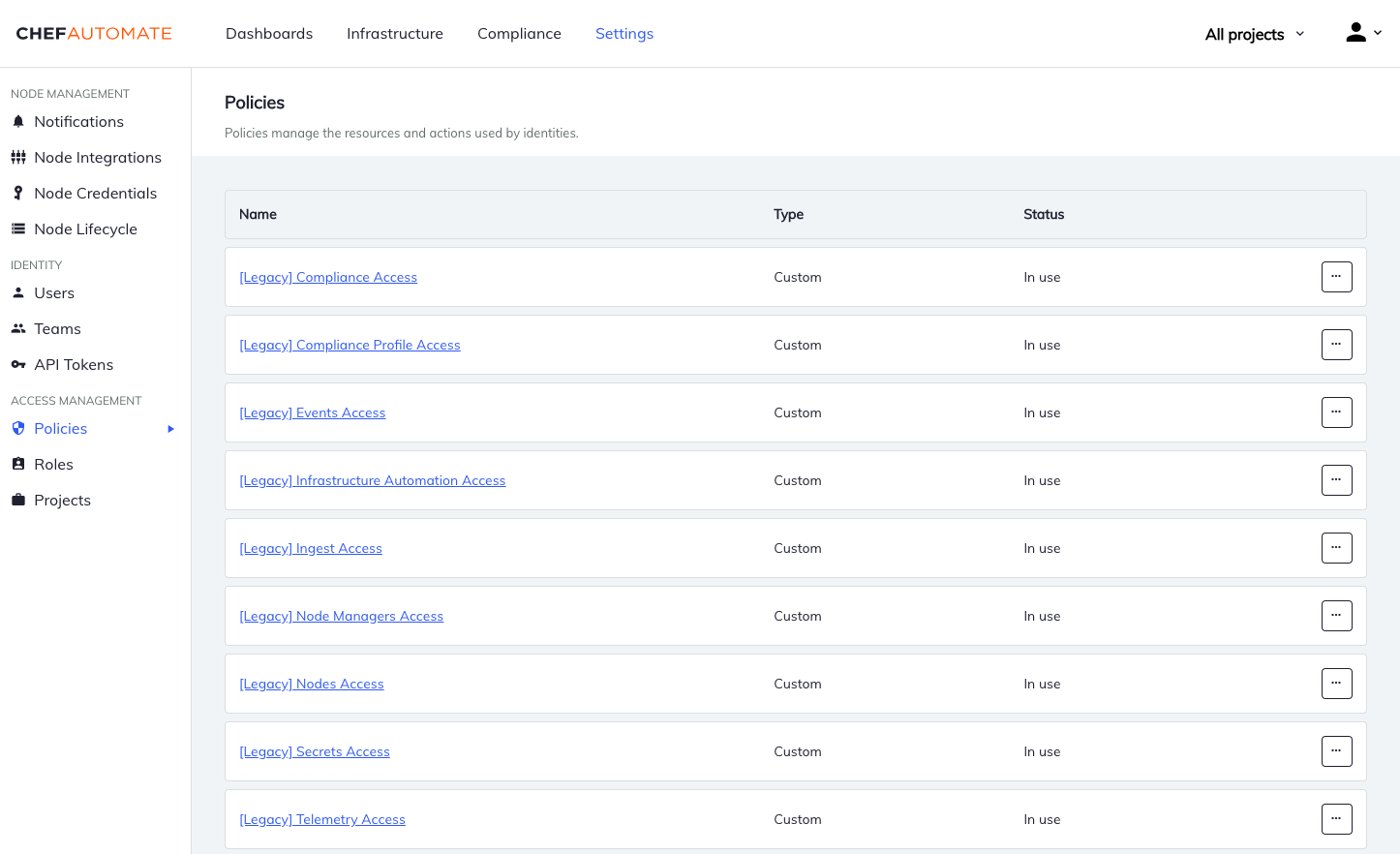
Policy Conversion
If you started on IAM v1 and migrated your IAM v1 policies to IAM v2, then you should move any members of your IAM v1 legacy policies to the appropriate IAM v2 policies, and afterwards, delete the IAM v1 legacy policies.
To delete a legacy policy, open the menu on any custom policy, which is located at the end of the policy row, and select Delete Policy from the menu.
A warning appears if members are still attached to the policy because deleting that policy disrupts access for all of its members. However, you will still be able to delete the policy.
The next few sections explain how to use Chef-managed policies and how to create custom policies.
Using Chef-Managed Policies
In this example conversion, you will create two local users and add them to default teams that are automatically included in default policies. Note that you could also add users directly to policies without the intermediate teams, but using teams can make managing your system more flexible.
Create Users
Follow the instructions on Creating Users to:
- Create a local user with the username
test_viewer. - Create a local user with the username
test_editor.
Add Users to Teams
Select Teams from the left navigation of the Settings tab.
Three teams are provided by default: admins, viewers, and editors.
Follow the instructions for Adding Users to a Team to:
- Add the user
test_viewerto the Chef-managedviewersteam. - Add the user
test_editorto the Chef-managededitorsteam.
After upgrading, those teams will be part of the Viewers and Editors policies, respectively.
The default Viewers policy is provided, so you can quickly grant read-only access to everything in Chef Automate, except for admin resources.
Similarly, the default Editors policy is provided, so you can quickly grant complete access to everything in Chef Automate, except for admin resources.
Once this step is done, the test_viewer and test_editor users may log in with appropriate system access.
Creating Custom Policies
The Chef-managed policies give you a starting point for permissions. You may want to write more fine-grained policies, tailored to the demands of your organization. Defining your own policies must be done from the command line.
As an example, let us say that you, the admin, want to delegate a portion of your tasks to a colleague, but without granting them full admin access.
In this case, you could create a policy called Team Devops Managers, which grants its members some–but not all–administrative privileges.
Create a JSON file in the editor of your choice.
Following JSON syntax, begin with the name property.
See the end of this section for a complete JSON policy example
"name": "Team Devops Managers",
The name field is for human consumption. When you want to refer to the policy in commands, you will need to know the policy’s ID.
Let us give this policy the ID value: team-managers-devops.
"id": "team-managers-devops",
Additionally, we can permission actions on this policy just like any other IAM resource by assigning it to one or more projects. If we leave the projects array empty, then we indicate the policy is unassigned. For example, anyone with permission to view unassigned policies can view this policy.
"projects": [],
Let us further assume you want user Bob as well as anyone on team gamma to be authorized by this policy. This grouping comprises the members array, as seen below.
"members": [
"user:local:bob",
"team:local:gamma",
],
Next, you will specify the permissions themselves–which in IAM v2 are the statements– declared as an array.
The statement allows us to specify the actions a user is permitted to take upon resources that have been assigned to a project.
The projects field on a statement is an array that may contain more than one existing project, a wildcard * to indicate permission to resources in any project, or (unassigned) to indicate permission to resources that have not been assigned to a project.
Note that the projects property in statements designates permission for the resources within the statement (here, that is iam:users and iam:teams), not for the policy itself, and cannot be left empty.
For more about projects, see Projects in the IAM Guide documentation.
In this case, we only need a single statement providing access to the get, list, and update actions for users and teams that have been assigned to the project project-devops.
{
"effect": "ALLOW",
"actions": [
"iam:users:update",
"iam:users:list",
"iam:users:get",
"iam:teams:update",
"iam:teams:list",
"iam:teams:get"
],
"projects": ["project-devops"],
},
Complete JSON Policy Example
{
"name": "Team Devops Managers",
"id": "team-managers-devops",
"projects": [],
"members": [
"user:local:bob",
"team:local:gamma"
],
"statements": [
{
"effect": "ALLOW",
"actions": [
"iam:users:update",
"iam:users:list",
"iam:users:get",
"iam:teams:update",
"iam:teams:list",
"iam:teams:get"
],
"projects": ["project-devops"]
}
]
}
Save your JSON file and refer to the IAM Policies API reference to send that policy data to Chef Automate.
Policy Membership
Users, teams, and API tokens can all be policy members. Both users and teams can be either locally or externally managed with LDAP or SAML.
Local Users and Teams
Local users and teams are managed directly by Chef Automate.
To add or delete members, navigate to the Policies list in the Settings tab, and then select a policy in the list to open its details. Select Members to view the current membership. Use the Add Members button to open a list of candidate members. This lists all those local members (both users and teams) that are not members of this policy. If all of the local members are already included in the policy, then this list will be empty. Select any members you wish to add to the policy. Use the Add Members button to complete the operation. This takes you back to the policy details, showing the revised membership list.
Member Expressions
Member expressions are required for externally managed users, and teams, as well as API tokens.
LDAP and SAML users’ information is saved outside of Chef Automate. You will need to manually enter the provider-qualified user or team. To do this, open any policy from the Policies list, then select Members. Select Add Members to open the list of candidate local users and teams. Near the bottom of the page, select the Add Member Expression button.
Note
Enter a member expression using the format team:<type>:<name> or user:<type>:<name>. Note that these expressions are case-sensitive.
- The
<type>expression is eitherldaporsaml. - The
<name>expression is the name of the user or team that the external identity provider knows. For example, this is a valid member expressionteam:ldap:editors_team_1, assuming theeditors_team_1team is known by your identity provider.
Alternately, you may add all teams to a policy using a wildcard as the last term in the member expression: team:ldap:* or team:saml:*.
The member expression dialog also supports tokens.
You enter a token using the expression token:<id>.
In order to find a token’s ID, visit the API Tokens page.
Projects
Projects are used to group and permission Chef Automate resources as well as ingested data, specifically Compliance reports, Chef Infra Server events, and Infrastructure nodes.
Projects can be managed via the Projects list under the Settings tab and consist of an ID, a name, and a collection of ingest rules. Project ingest rules are lists of conditions used only when assigning ingested resources to projects, so they are not relevant when assigning IAM resources such as teams or roles.
Configuring Project Limit
By default, Chef Automate limits you to 300 projects. You can increase the project limit using the command line.
First, write the file with your new project limit:
cat << EOF > authz.toml
[auth_z.v1.sys.service]
project_limit = <desired-max-projects>
EOF
Then, update the existing Chef Automate configuration:
chef-automate config patch authz.toml
Note: As a consequence of increasing the project limit, you may see slower loading times in the UI.
Creating a Project
To create a project, navigate to the Projects list under the Settings tab and select Create Project. You will need to provide a name and can optionally edit the ID. You must create a project before you can assign any resources to it.
When you initiate the project creation, the system creates the project, but also three supplemental policies for your convenience:
| Policy Name | Policy ID | Associated Role |
|---|---|---|
<project-name> Project Owners | <project-name>-project-owners | Project Owner |
<project-name> Project Editors | <project-name>-project-editors | Editor |
<project-name> Project Viewers | <project-name>-project-viewers | Viewer |
These policies are discussed in more detail in Project Policies.
Assigning Teams and Tokens to Projects
Projects can be assigned to Automate-created teams or tokens on creation or update.
To assign a team to projects, select a team from the Teams list, then select Details. Likewise, to assign a token to projects, select a token from the API tokens list, then select Details. In either case, you can select projects from the projects dropdown to assign.
You may also assign teams and tokens to projects on creation. In the creation modal, select any projects to which the new resource should belong.
If you would like to delegate ownership of a project to another user so that they may assign resources, you will want to make that user a Project Owner of that project.
Assigning Ingested Resources to Projects
While Chef Automate’s local teams and tokens can be directly assigned to a project, ingested resources must be assigned to projects using ingest rules.
Project ingest rules are used to associate ingested resources with projects within Chef Automate. An ingest rule contains conditions that determine if an ingested resource should be moved into the rule’s project. Each condition contains an attribute, operator, and value. See IAM Project Rules API reference for details on how to manage project rules.
In this example, after creating a project with the ID project-devops, you will add an ingest rule to this new project.
You will update projects to apply this new project rule, causing all matching ingested resources to be associated with project-devops.
You will then use the global project filter to filter your ingested data by project-devops.
First, determine which ingested resources should belong to the project. In this example, we want to add the following ingested resources to project-devops:
- Compliance reports with Chef Organization
devops - Infrastructure nodes with Environment
devand Chef Tagdevops-123 - Actions on Chef Infra Servers
devops.pizzaordevops.dog
You may want to verify that those filters work as expected on the Event Feed, Client Runs, and Reports pages.
Navigate to the project details page of project-devops, by selecting the project name on the project list page.
Select the Create Rule button to create a new project rule. Choose the resource type Node, then fill in the first condition’s fields.
Feel free to create fake ingest data that corresponds to the example json below, or come up with a condition that matches your existing data set.
Warning
{
"id": "devops-rule",
"name": "devops rule",
"type": "NODE",
"project_id": "project-devops",
"conditions": [
{
"operator": "EQUALS",
"attribute": "CHEF_ORGANIZATION",
"values": [
"devops"
]
}
]
}
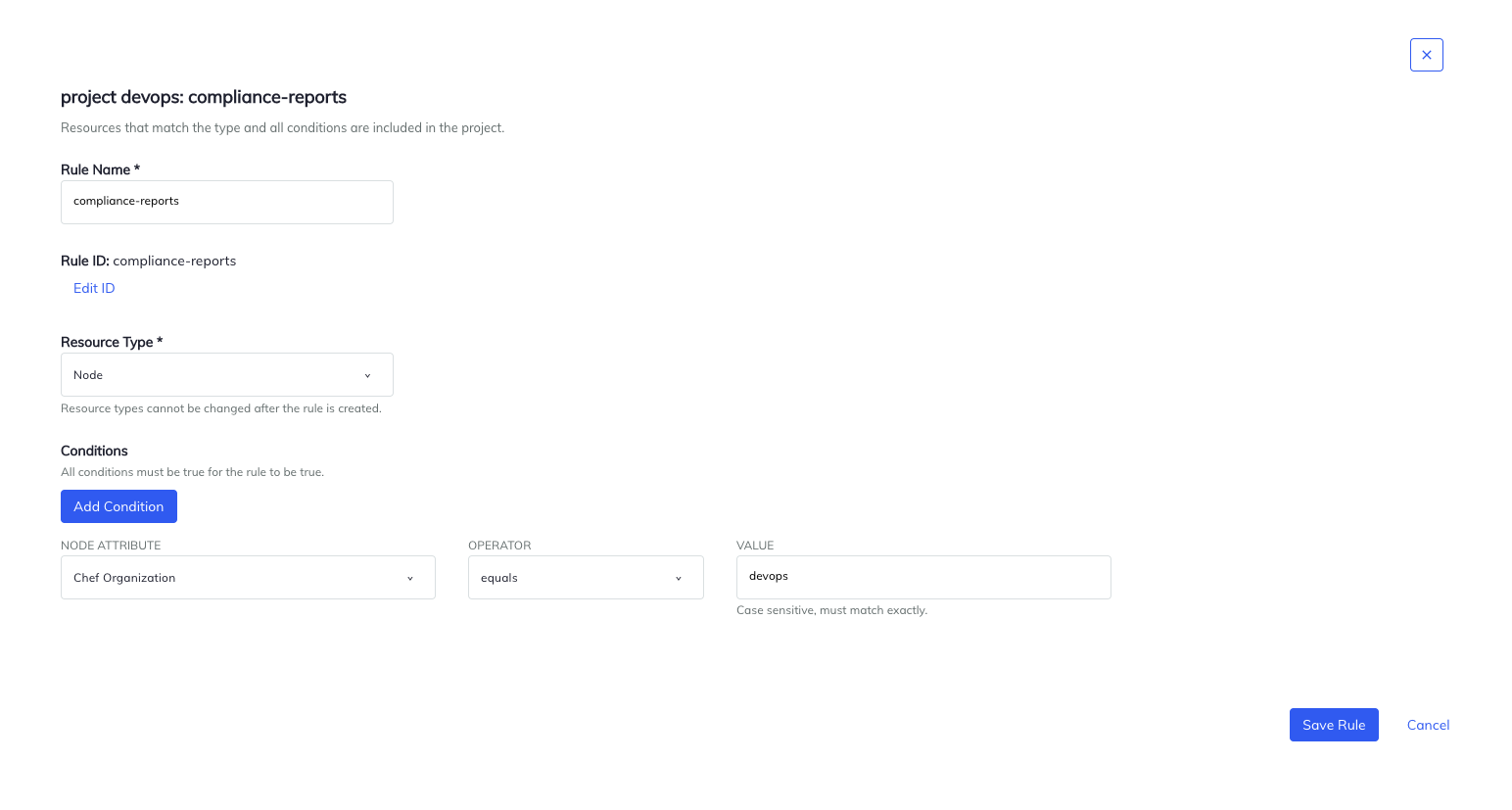
Save the rule. If you later need to change the name or the conditions, select the project rule name on the project details page.
When edits are pending, a banner will be shown at the bottom of every page. Selecting the Update Projects button on that banner will apply those changes.
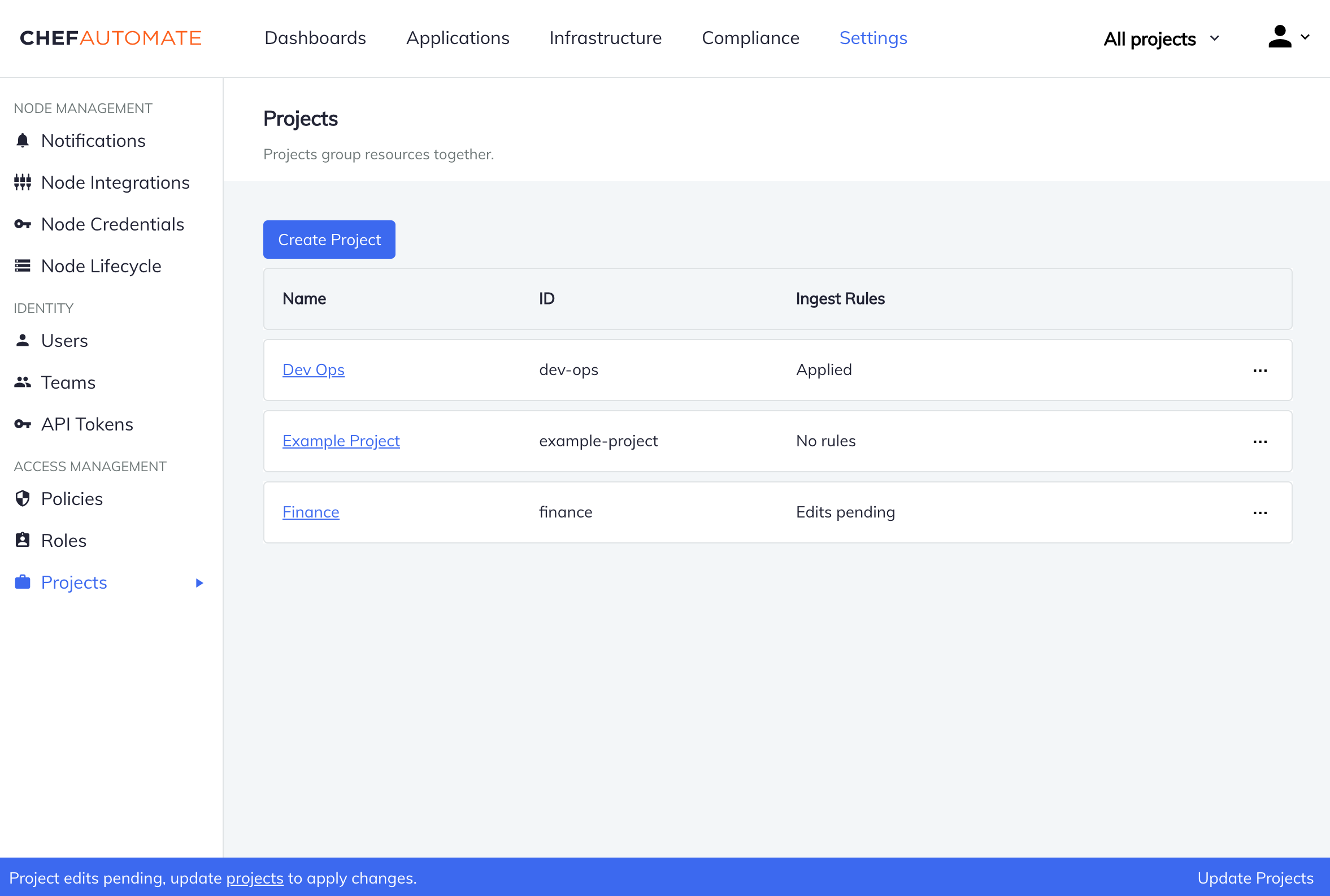
Updating a project begins an operation that applies all pending rule edits and then moves ingested resources into the correct projects according to those latest changes. An ingested resource is moved into a project if it matches at least one of the project’s rules.
In this example, upon successful update, all ingested resources whose Chef Organization matches devops will be considered a part of the project project-devops.
Only these resources will appear in Automate’s dashboards when the project-devops project has been selected in the global project filter.
A percentage count appears in the bottom banner while the operation takes place.
You may cancel the update at any time by selecting the Stop Project Update button in the banner and confirming the cancel in the modal that pops up.
Warning
Once rules have been successfully applied, the banner will be dismissed until the next time there are pending edits to any project.
To verify that the ingested resources have been moved into the correct projects, select project-devops in the global projects filter, which is on the top navigation. The data in Chef Automate filters by the selected project-devops project.
In this example, the effect is revealed by navigating to the Compliance Reports’ Nodes tab, which only features nodes that belong to the devops Chef Organization.
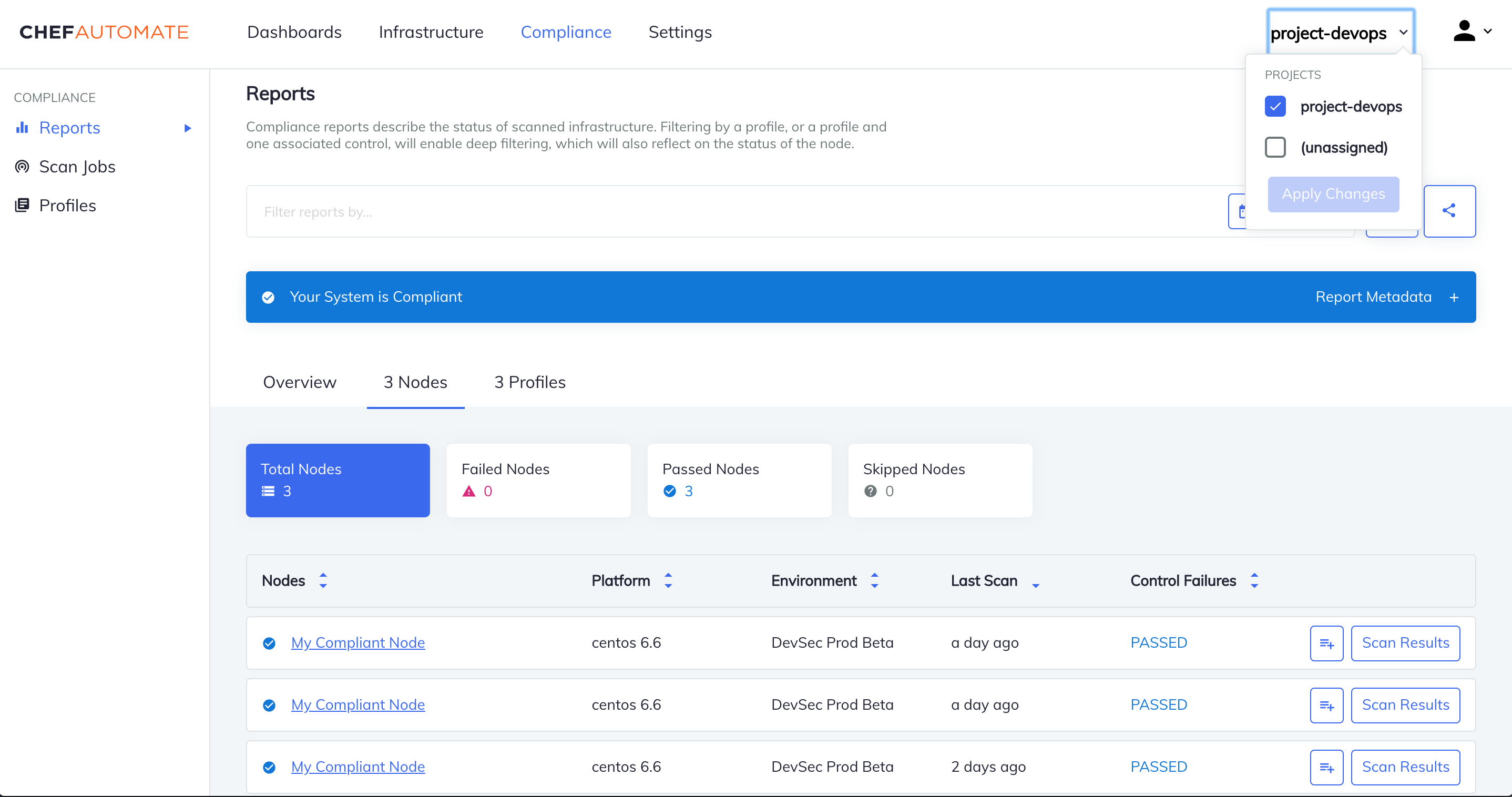
Now that we have the first set of our ingested data associated with our new project, let us add another condition and a new rule to add more data to project-devops.
Note
Note
Event type to be associated with the correct project. A condition of type Node will not match an event, even if the condition’s operator, attribute, and value all match exactly (and vice versa with Event project rules and nodes).Return again to the project detail page and create two new ingest rules by selecting Create Rule. Creating new rules will expand the data set under project-devops,
because an ingested resource need only match one rule to be placed in the project.
The first rule should contain two conditions.
Fill in the first condition with attribute Environment, operator equals, and value dev, or any value matching your data set.
Select Add Condition to add another condition with attribute Chef Tag, operator equals, and devops-123.
Save the rule.
Note
For the second rule, choose resource type Event. Fill in the first condition with attribute Chef Server, operator member of, and value devops.pizza, devops.dog, or any values matching your data set.
Setting the project rule Resource Type determines what condition attributes are available to select. Event rule conditions can only have the attributes Chef Organization or Chef Server.
Rules of type Node can have conditions with attributes Chef Organization, Chef Server, Environment, Chef Role, Chef Tag, Chef Policy Name, Chef Policy Group.
Select the Update Projects button from the bottom banner.
Upon completion of the update, you should be able to filter by project-devops across Automate’s dashboards and see only the ingested data that you expect.
Effortless Infra Project
To create a project that contains all Effortless Infra nodes, create a ingest rule with resource type Node and a condition that uses attribute Chef Server, operator equals, and value localhost.
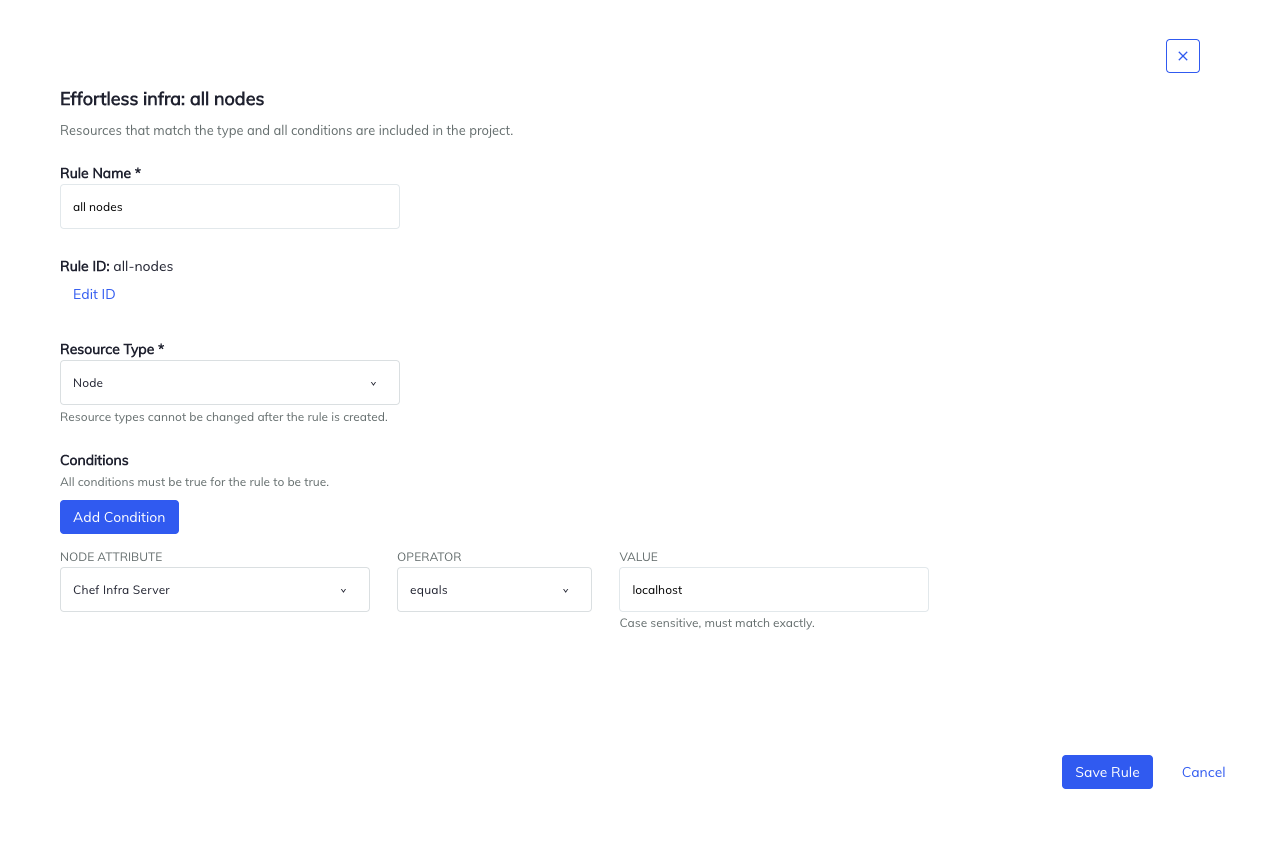
The above rule matches on a node’s Chef Infra Server field, which is set to localhost. This rule works because all Effortless Infra nodes list the Chef Infra Server attribute as localhost.
If desired, create subgroups of Effortless Infra nodes by adding a second condition that matches a specific Chef Policy Name.
Project Policies
When you create a project, Chef Automate automatically creates three supplemental policies. This next table further describes the roles associated with these policies.
| Policy Name | Role | Description of role |
|---|---|---|
<project-name> Project Viewers | Viewer | View everything in the project except IAM |
<project-name> Project Editors | Editor | Do everything in the project except IAM |
<project-name> Project Owners | Project Owner | Editor + view and assign projects |
Consider the Project Viewers policy, which uses the Viewer role. The same Viewer role is also used in the default Viewer policy, which lets a user view everything in the system except IAM. Using the Viewer role in Project Viewers policy restricts the scope to your new project, and users attached to your Project Viewers policy will be able to view objects only associated with your project.
Assume you named your project Devops, and have two users: Terry and Kelly. If Terry needs to view Devops-scoped resources, then add Terry as a member to the Devops Project Viewers policy. If Kelly needs the ability to edit Devops-scoped resources, then add Kelly to the Devops Project Editor policy.
When Terry is a member of the Devops Project Viewers policy and not a member of any other policy, they will only be able to see resources assigned to Devops. They will not be able to update or delete them. Kelly, however, will be able to update and delete.
See Policy Membership for more information on policy membership.
Restoring Admin Access
While we have safeguards to prevent it, it is possible to lock yourself out of Chef Automate. If you have root access to the node where Chef Automate is installed, use the following commands to restore admin access:
This command resets the local admin user’s password and ensures that the user is a member of the local admins team, which is a permanent member of the Chef-managed Administrator policy.
chef-automate iam admin-access restore <your new password here>
Was this page helpful?